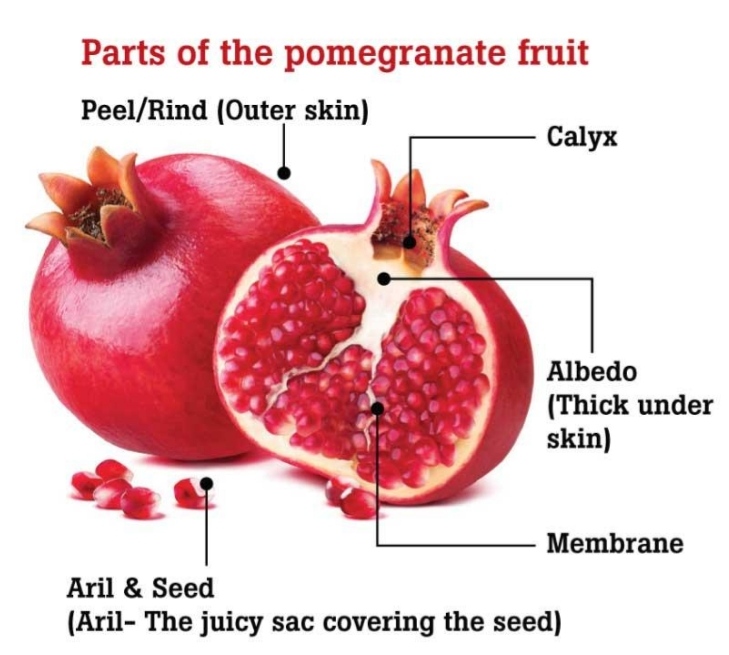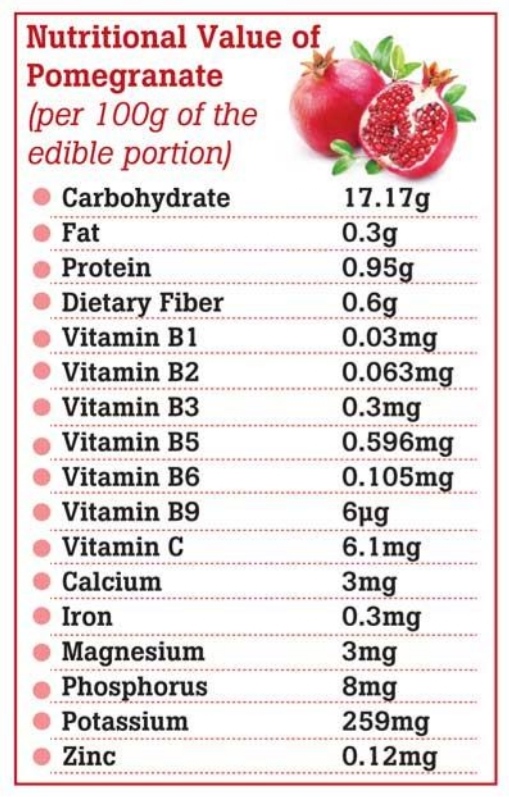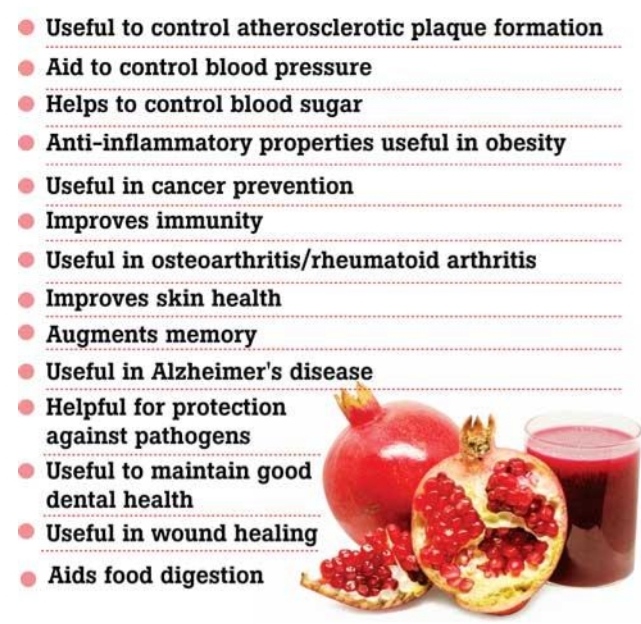Nutritional and medicinal values of pomegranate

Pomegranate is a fruit with full of nutritional factors in each part of it; and this gives a high medicinal value to it. It can be cultivated in both cold and hot climates, provided that a good water supply is present in hot climates. Pomegranate is grown nearly everywhere in the plains and hills but cultivation can be seen mainly in dry zones . It will take 6-8years to get the maximum harvest from a pomegranate tree. Depending on the conditions, about 300 pomegranates can be plucked from one tree per year. Pomegranate can be stored below 50C for about 7months.
Important pomegranate varieties cultivated in India are Alandi or Vadki, Dholka, Kandhari, Kabul, Muskati Red, Paper Shelled, Spanish Ruby, Ganesh (GB I), G 137, P 23, P 26, Mridula, Aarakta, Jyoti, Ruby, IIHR Selection, Yercaud 1 and Co 1.
Pomegranate (Punica granatum) is one of the commercially important fruit crops of India. It is native to Iran (Persia). Pomegranate is cultivated commercially only in Maharashtra. Small scale plantations are also seen in Gujarat, Rajasthan, Karnataka, Tamil Nadu , Andhra Pradesh, Uttar Pradesh, Punjab and Haryana. Fruit is consumed fresh or in the form of juice, jam, squash and syrup. Among all forms, canned slices and juice are in much demand in India, constituting about 70% of the production.
India exports pomegranate mainly to Bahrain, Kuwait, Oman, Saudi Arabia, U.A.E., Netherlands etc. Varieties which are in demand internationally include Ganesh and Aarakta. The trend in export of pomegranate from India during the period 1999-2000 to 2001-02 is given in Graph 1.
Country-wise export of pomegranate from India during 2001-02.
| Country | Quantity (Tonnes) | Value (Rs. in lakhs) |
| U.A.E. | 3224.55 | 653.77 |
| Oman | 415.92 | 123.75 |
| U.K. | 202.82 | 82.19 |
| Bahrain | 198.87 | 51.77 |
| Kuwait | 149.64 | 31.06 |
| Netherlands | 150.07 | 23.66 |
| Saudi Arabia | 172.32 | 28.43 |
| Others | 259.51 | 47.22 |
| Total | 4773.70 | 1041.85 |

Weight percentage wise, the juice of the fruit contains the highest which is 46% and peel and seeds contain 43% and 11% respectively.
Nutritional Value of Pomegranate (per 100g of the edible portion)

Health benefits of Pomegranate
Recent studies have demonstrated potent anti- oxidant, anti-inflammatory and anti-microbial effects of pomegranate. These properties have lead in to many health benefits.
Due to the anti oxidant properties, Pomegranate has the ability to scavenge free radicals which damages the body cells and also has the ability to prevent lipid peroxidation which lead to cholesterol plaque generation.
Anti inflammatory properties of Pomegranate has given a good medicinal value to pomegranate. The compounds containing in Pomegranate helps to control the inflammatory processes which is seen in many disease generation processes.
Pomegranate also has anti microbial actions which act against bacteria, fungi and viruses. It prevents bacterial growth and also prevents DNA and RNA replication of viruses. Thus pomegranate has a place in treating infections.
Why you should eat Pomegranate?

Do NOT throw away the pomegranate peel!
People eat the pomegranate arils, some eat the pomegranate seeds and almost all the people throw away the pomegranate peel. Though Pomegranate peel has a bitter taste, it is rich in compounds with anti oxidant, anti inflammatory and anti microbial properties. Thus it is very wise to consume pomegranate peel without throwing away. Pomegranate peels can be broken in to small pieces then dried and use to make tea or it can be dried and then powdered and taken in to use. The powdered peel can be mixed with bee honey and consumed.
Pomegranate also has anti microbial actions which act against bacteria, fungi and viruses. It prevents bacterial growth and also prevents DNA and RNA replication of viruses. Thus pomegranate has a place in treating infections



